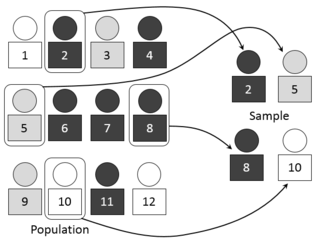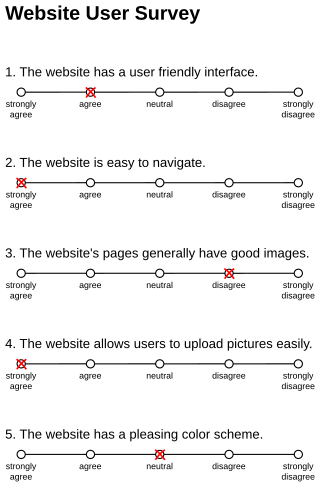Related Research Articles

In statistics, quality assurance, and survey methodology, sampling is the selection of a subset or a statistical sample of individuals from within a statistical population to estimate characteristics of the whole population. Statisticians attempt to collect samples that are representative of the population. Sampling has lower costs and faster data collection compared to recording data from the entire population, and thus, it can provide insights in cases where it is infeasible to measure an entire population.
Concept testing is the process of using surveys to evaluate consumer acceptance of a new product idea prior to the introduction of a product to the market. It is important not to confuse concept testing with advertising testing, brand testing and packaging testing, as is sometimes done. Concept testing focuses on the basic product idea, without the embellishments and puffery inherent in advertising.
Questionnaire construction refers to the design of a questionnaire to gather statistically useful information about a given topic. When properly constructed and responsibly administered, questionnaires can provide valuable data about any given subject.
Survey methodology is "the study of survey methods". As a field of applied statistics concentrating on human-research surveys, survey methodology studies the sampling of individual units from a population and associated techniques of survey data collection, such as questionnaire construction and methods for improving the number and accuracy of responses to surveys. Survey methodology targets instruments or procedures that ask one or more questions that may or may not be answered.
An opinion poll, often simply referred to as a survey or a poll, is a human research survey of public opinion from a particular sample. Opinion polls are usually designed to represent the opinions of a population by conducting a series of questions and then extrapolating generalities in ratio or within confidence intervals. A person who conducts polls is referred to as a pollster.
The availability heuristic, also known as availability bias, is a mental shortcut that relies on immediate examples that come to a given person's mind when evaluating a specific topic, concept, method, or decision. This heuristic, operating on the notion that, if something can be recalled, it must be important, or at least more important than alternative solutions not as readily recalled, is inherently biased toward recently acquired information.
In psychology, the Asch conformity experiments or the Asch paradigm were a series of studies directed by Solomon Asch studying if and how individuals yielded to or defied a majority group and the effect of such influences on beliefs and opinions.
In psychology, a projective test is a personality test designed to let a person respond to ambiguous stimuli, presumably revealing hidden emotions and internal conflicts projected by the person into the test. This is sometimes contrasted with a so-called "objective test" / "self-report test", which adopt a "structured" approach as responses are analyzed according to a presumed universal standard, and are limited to the content of the test. The responses to projective tests are content analyzed for meaning rather than being based on presuppositions about meaning, as is the case with objective tests. Projective tests have their origins in psychoanalysis, which argues that humans have conscious and unconscious attitudes and motivations that are beyond or hidden from conscious awareness.

Response bias is a general term for a wide range of tendencies for participants to respond inaccurately or falsely to questions. These biases are prevalent in research involving participant self-report, such as structured interviews or surveys. Response biases can have a large impact on the validity of questionnaires or surveys.
The "ceiling effect" is one type of scale attenuation effect; the other scale attenuation effect is the "floor effect". The ceiling effect is observed when an independent variable no longer has an effect on a dependent variable, or the level above which variance in an independent variable is no longer measurable. The specific application varies slightly in differentiating between two areas of use for this term: pharmacological or statistical. An example of use in the first area, a ceiling effect in treatment, is pain relief by some kinds of analgesic drugs, which have no further effect on pain above a particular dosage level. An example of use in the second area, a ceiling effect in data-gathering, is a survey that groups all respondents into income categories, not distinguishing incomes of respondents above the highest level measured in the survey instrument. The maximum income level able to be reported creates a "ceiling" that results in measurement inaccuracy, as the dependent variable range is not inclusive of the true values above that point. The ceiling effect can occur any time a measure involves a set range in which a normal distribution predicts multiple scores at or above the maximum value for the dependent variable.
The social norms approach, or social norms marketing, is an environmental strategy gaining ground in health campaigns. While conducting research in the mid-1980s, two researchers, H.W. Perkins and A.D. Berkowitz, reported that students at a small U.S. college held exaggerated beliefs about the normal frequency and consumption habits of other students with regard to alcohol. These inflated perceptions have been found in many educational institutions, with varying populations and locations. Despite the fact that college drinking is at elevated levels, the perceived amount almost always exceeds actual behavior. The social norms approach has shown signs of countering misperceptions, however research on changes in behavior resulting from changed perceptions varies between mixed to conclusively nonexistent.

In sociology, social psychology studies the relationship between the individual and society. Although studying many of the same substantive topics as its counterpart in the field of psychology, sociological social psychology places relatively more emphasis on the influence of social structure and culture on individual outcomes, such as personality, behavior, and one's position in social hierarchies. Researchers broadly focus on higher levels of analysis, directing attention mainly to groups and the arrangement of relationships among people. This subfield of sociology is broadly recognized as having three major perspectives: Symbolic interactionism, social structure and personality, and structural social psychology.
Facet theory is a metatheory for the multivariate behavioral sciences that posits that scientific theories and measurements can be advanced by discovering relationships between conceptual classifications of research variables and empirical partitions of data-representation spaces. For this purpose, facet theory proposes procedures for (1) Constructing or selecting variables for observation, using the mapping sentence technique, and (2) Analyzing multivariate data, using data representation spaces, notably those depicting similarity measures, or partially ordered sets, derived from the data.
In control theory, affect control theory proposes that individuals maintain affective meanings through their actions and interpretations of events. The activity of social institutions occurs through maintenance of culturally based affective meanings.
Participation bias or non-response bias is a phenomenon in which the results of elections, studies, polls, etc. become non-representative because the participants disproportionately possess certain traits which affect the outcome. These traits mean the sample is systematically different from the target population, potentially resulting in biased estimates.
Choice modelling attempts to model the decision process of an individual or segment via revealed preferences or stated preferences made in a particular context or contexts. Typically, it attempts to use discrete choices in order to infer positions of the items on some relevant latent scale. Indeed many alternative models exist in econometrics, marketing, sociometrics and other fields, including utility maximization, optimization applied to consumer theory, and a plethora of other identification strategies which may be more or less accurate depending on the data, sample, hypothesis and the particular decision being modelled. In addition, choice modelling is regarded as the most suitable method for estimating consumers' willingness to pay for quality improvements in multiple dimensions.
Thin-slicing is a term used in psychology and philosophy to describe the ability to find patterns in events based only on "thin slices", or narrow windows, of experience. The term refers to the process of making very quick inferences about the state, characteristics or details of an individual or situation with minimal amounts of information. Research has found that brief judgments based on thin-slicing are similar to those judgments based on much more information. Judgments based on thin-slicing can be as accurate, or even more so, than judgments based on much more information.
Conformity is the act of matching attitudes, beliefs, and behaviors to group norms, politics or being like-minded. Norms are implicit, specific rules, guidance shared by a group of individuals, that guide their interactions with others. People often choose to conform to society rather than to pursue personal desires – because it is often easier to follow the path others have made already, rather than forging a new one. Thus, conformity is sometimes a product of group communication. This tendency to conform occurs in small groups and/or in society as a whole and may result from subtle unconscious influences, or from direct and overt social pressure. Conformity can occur in the presence of others, or when an individual is alone. For example, people tend to follow social norms when eating or when watching television, even if alone.
Impression formation in social psychology refers to the processes by which different pieces of knowledge about another are combined into a global or summary impression. Social psychologist Solomon Asch is credited with the seminal research on impression formation and conducted research on how individuals integrate information about personality traits. Two major theories have been proposed to explain how this process of integration takes place. The Gestalt approach views the formation of a general impression as the sum of several interrelated impressions. As an individual seeks to form a coherent and meaningful impression of another individual, previous impressions significantly influence the interpretation of subsequent information. In contrast to the Gestalt approach, the cognitive algebra approach asserts that individuals' experiences are combined with previous evaluations to form a constantly changing impression of a person. A related area to impression formation is the study of person perception, making dispositional attributions, and then adjusting those inferences based on the information available.

Nalini Ambady was an Indian-American social psychologist and a leading expert on nonverbal behavior and interpersonal perception. She was born in Calcutta, India and earned her bachelor’s degree at Lady Shri Ram College for women, Delhi University. She furthered her education by moving to the United States for her master’s degree in psychology, from the College of William and Mary, and later received her PhD in social psychology from Harvard. While completing her research at Harvard, she met her husband Raj Marphatia, who was studying at Harvard Law school.
References
- ↑ Rossi, Peter H., and Steven L. Nock, Eds. Measuring Social Judgments: The Factorial Survey Approach (Sage, 1982); Rossi, P. H., and Richard A. Berk (1985). "Varieties of normative consensus" American Sociological Review50: 333-347
- ↑ Heise, David R. Surveying Cultures: Discovering Shared Conceptions and Sentiments (Wiley Interscience, 2010), p. 78
- ↑ Heise, D. R. Surveying Cultures, p. 79
- ↑ Heise, D. R., Surveying Cultures, pp. 86-120